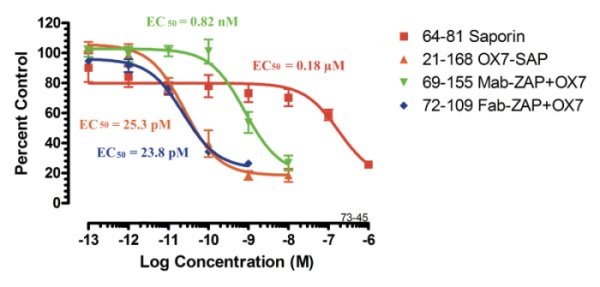New Secondary Conjugates – Fab-ZAPs – Use Monovalent Secondary Antibodies Linked to Saporin
For the past decade scientists have extensively used secondary conjugates (e.g. Mab-ZAP; Cat. #IT-04, and Hum-ZAP; Cat. #IT-22) to make their own targeted toxins for in vitro use. The ability to combine: 1) a primary antibody to a cell-surface marker with 2) a secondary conjugate, in order to eliminate cells is a valuable tool in determining antibody specificity and internalization.
In theory, there are some possible limitations to the original product line of secondary conjugates to serve as a singular diagnostic tool. These secondary conjugates are made with whole molecule IgG secondary antibodies that recognize both the heavy and light chain of primary antibodies. The bivalent nature of these antibodies offers the possibility that cross-linking could occur on the cell surface, which can contribute to a phenomenon known as “cap formation.” When molecules on the surface of a cell are cross-linked they are moved to one end of the cell to form a “cap,” the formation of which can induce some level of endocytosis that leads to false positives (due to inappropriate internalization) in a cytotoxicity assay.
Although we have no data or customer feedback that demonstrates that this has actually occurred in practice, we decided to be proactive and provide our customers with additional tools to meet any potential concerns. As a result, ATS is proud to release a new line of secondary conjugates (Fab-ZAP) produced with monovalent antibodies. These products eliminate the possibility of cap formation as cross-linking of the Fab-ZAP molecules cannot occur, while preserving all of the qualities that make an effective in vitro diagnostic tool. The Fab-ZAP products will still recognize the heavy and light chains of antibodies, and should be used in the same way and at the same molar concentrations as the original secondary conjugates. In fact, preliminary assays using Fab-ZAP-mouse have demonstrated an unexpected lower EC50 when directly compared to Mab-ZAP in a cytotoxicity assay (see Fig. 1).
Fab-ZAP (mouse) – Cat. #IT-48
25 μg / 100 μg / 250 μg
Fab-ZAP (mouse) uses your primary mouse monoclonal IgG antibody to target and eliminate cells that recognize your primary antibody.
Fab-ZAP (human) and Fab-ZAP (rabbit) – In Production

